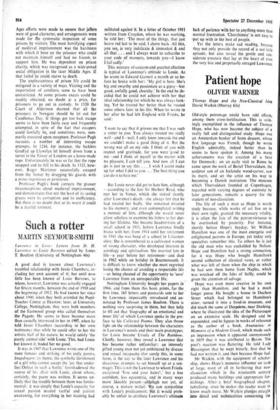All mod cons
MICHAEL BOBBIE
Imprisonment in Medieval England Ralph B. Pugh (cuP 90s) This is a pioneer work of great importance for students of English legal and social history. The author modestly describes it as 'rugged,' and
expects its eventual replacement by 'a more
polished and more sophisticated successor.' It is. however, unlikely to be obsolete or even obsolescent in the foreseeable future (which is just as well, in view of the price), and it is decidedly the reverse of rugged. Professor Pugh's notional supplanter could be pardoned for taking fright at the forbidding mass of original materials patiently combed by the author for this long study. Even if he per- severes, he will certainly be hard put to it to treat his complex subject with comparable pre- cision and clarity.
Professor Pugh's book describes, as com- pletely as the evidence allows, every aspect of prison practice in England from the Anglo-• Saxon period to the early sixteenth century. The development of the various uses of im- prisonment, custodial, coercive and penal, is carefully analysed. The numerous offences of commission and omission which might lead a man to prison are discussed. There are chapters on the types of prison, private, municipal or royal, in which he might find himself, and more detailed accounts of the famous London prisons, such as the Tower, Marshalsea, Fleet, Newgate and Ludgate. The structure, furnish- ings and maintenance of prisons, the welfare of their inmates, the responsibilities and con- duct of jailers, the ease and frequency of escapes, the types of jail delivery and the prac- tices of bail and enlargement are all treated in detail and documented with convincing thoroughness.
To modern ears 'medieval prison' is a phrase of gothic horror, suggesting gloomy dungeons, rank air, rats, fetters and ingenious instruments of torture. Many prisons no doubt boasted all these amenities (except perhaps instruments of torture, which Professor Pugh notes in only one prison inventory, that of Hertford), but the types and standards of prison accommodation were infinitely varied. The best prisons, such as Newgate, which was ventilated by a wind- mill and well supplied with privies and drain- age, offered a wide range of accommodation, including rooms which were almost comfort- able. The Fleet had a bar, and something akin to a college buttery. In 1523 it even had a warden who joined in Christmas games with the prisoners.
Prisoners were responsible for their own maintenance, and got the standard of comfort and quality of food they could afford. As the author points out, medieval penal imprisonment may have been wholly vengeful in inspiration, but it was not deliberately barbarous. Terms were short, three years at the most, and tended to get shorter throughout the period. The mal- treatment of prisoners was discountenanced and punished when detected. In the later Middle
Ages efforts were made to ensure that jailers were of good character, and arrangements were made for ti5e systematic inspection of some prisons by visitors. The most horrifying aspect of medieval imprisonment was the harshness with which it bore on the prisoner who could not maintain ,himself and had no friends to support him. He was dependent on prison charity, which was recognised as a widespread social obligation in the later Middle Ages. If that failed he could starve to death.
The unpleasantness of prison life could be mitigated in a variety of ways. Visiting and the importation of comforts seem to have been unrestricted. At some prisons exeats could be readily obtained, no doubt at a price, for prisoners to go out in custody. In 1520 the Court of Aldermen decreed that all the prisoners in Newgate should be let out for Candlemas Day. If things got too bad, escape seems to have been fairly easy and frequently attempted, in spite of the fact that escapers could lawfully be, and sometimes were, sum- marily executed upon recapture. Professor Pugh recounts a number of interesting escape attempts. In 1244, for instance, the luckless Gruffyd ap Llywelyn let himself down from a turret in the Tower of London on a home-made rope. Unfortunately he was so fat that the rope snapped and he fell to his death. In 1323, how- ever, Roger Mortimer successfully escaped from the Tower by drugging his guards with a pouts ingeniosus et pestiferus.
Professor Pugh's book corrects the grosser misconceptions about medieval imprisonment, and demonstrates that not the least of its saving graces were its corruption and its inefficiency. But there is no doubt that at its worst it'could be a fearful torment.



































 Previous page
Previous page